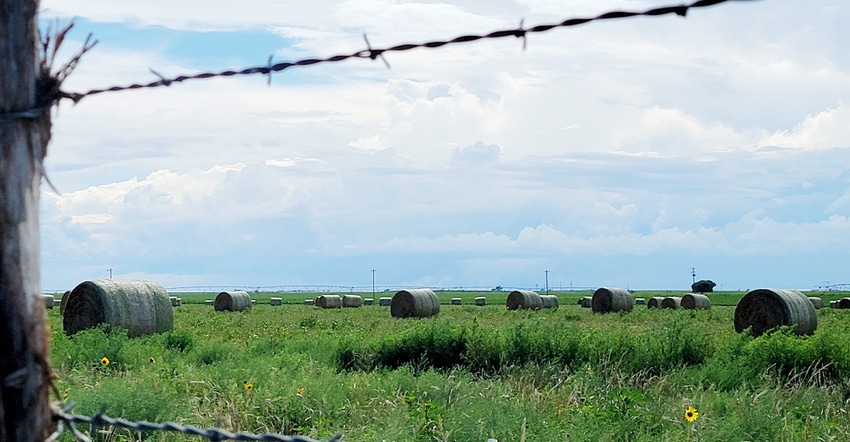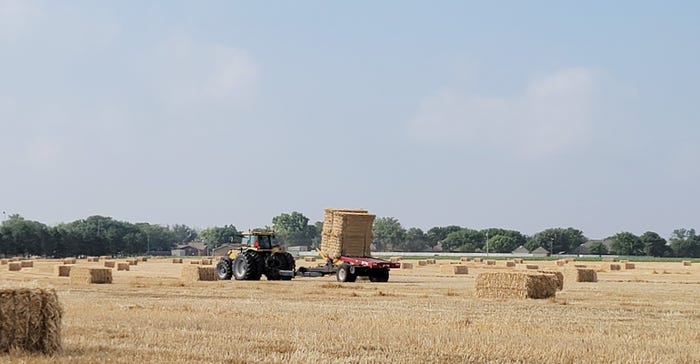
Hay producers and buyers are encouraged to market hay based on weight rather than bale size, says Texas A&M AgriLife Agronomist Calvin Trostle, Lubbock, in his recent Texas Row Crops Newsletter.
"Bales even of similar size, especially round bales, can vary by 20% in weight," Trostle says. "Hay transactions based on weight are better. The buyer and seller better understand what is being marketed. No guesswork, which is not always reliable. "
To stay up-to-date on hay prices, the USDA publishes a Direct Hay Report. "This is useful for hay growers and buyers for a snapshot of current prices," Trostle says. The reports are broken down by state including, Texas, Oklahoma and New Mexico.
The Texas report is published every two weeks with the most current report published Friday, March 4. The report is divided into four regions -- Panhandle, Central, South and West -- and includes current market prices for alfalfa (including different grades of supreme/premium/good), bermudagrass, sorghum (meaning sorghum/sudan, not grain sorghum stalks), milo, millet and wheat hay.
The Oklahoma report is published every three weeks, with the most current issue published March 4 as well. Oklahoma's report is split into five areas: Central, East, North Central, Northeast and Northwest. The report includes market prices in hay categories similar to Texas but also covers prairie/meadow grass, oat, rye grass, grass and mixed grasses.
 (Photos by Shelley E. Huguley)
(Photos by Shelley E. Huguley)
The New Mexico report is not published as frequently, with the last report uploaded Nov. 5, 2021. According to the website, reporting for the state will resume in late April. New Mexico's data is divided into six regions -- Central, East, North Central, South, Southeast and Southwest-- and lists alfalfa, alfalfa/grass mix, alfalfa/fescue mix, barley, grass, oat, sudan and wheat hay.
"Some prices are per ton (preferred)," Trostle says. "Others are based on bale size (large square, small square, round). AgriLife strongly recommends the Texas hay industry — all buyers and sellers — market hay based on weight rather than bale size."
Other Hay Buying/Selling Tips
"Like any market transaction clarity in what is bought and sold is best. This is why we recommend hay sales be based on weight rather than bale or bale size," Trostle says. "This is fair and it eliminates guesswork, which helps maintain a good relationship between buyer and seller."
Trostle listed additional considerations when buying and selling hay in Texas:
Is forage nutritive value being tested? This further clarifies what is being bought and sold. "I especially recommend hay buyers request permission to take your own forage sample for protein/fiber/nutrient analysis. This protects you from overpaying (or underselling) for forage. Hay quality testing is routine for alfalfa sales. If a hay seller will not allow the buyer to test for forage quality prior to purchase, then look for another seller if you can," Trostle says.
If only purchasing two large round bales or a dozen small squares, it may not be worth forage testing, although a quality analysis is still valuable.
Forage testing services are available in labs throughout the state including at Texas A&M AgriLife’s Soil, Water, and Forage Testing Lab, https://soiltesting.tamu.edu/, in College Station.

If a forage quality analysis is not available or feasible, a visual estimate of relative forage quality can still be attained. Determine at what stage of growth is the forage. For example, a sorghum/sudan hay sample where you can see in the bale the forage was in boot stage (no heading) will be worth more, have more nutritive value versus hay that is headed out. Alfalfa can be gauged by a general estimate of forage nutritive value based on steminess and whether there was any bloom.
General guidelines on the quality and nutritive value of forages. Forage quality increases when you move from the following:
Grass to legumes
Perennial forages to annual forages
Warm season forages to cool season forages
Mature forages (more advanced state of growth) to immature forages, especially when still in vegetative stage. "The younger it is, the better it is," Trostle reminds.
Traditional annual grass forages for corn, sorghum/sudan (haygrazer), hybrid pearl millet to brown-mid rib forages of the same crop.
All hay sales are based on a dry matter basis.
For more information, contact Trostle at 806-746-6101 or [email protected].
About the Author(s)
You May Also Like






